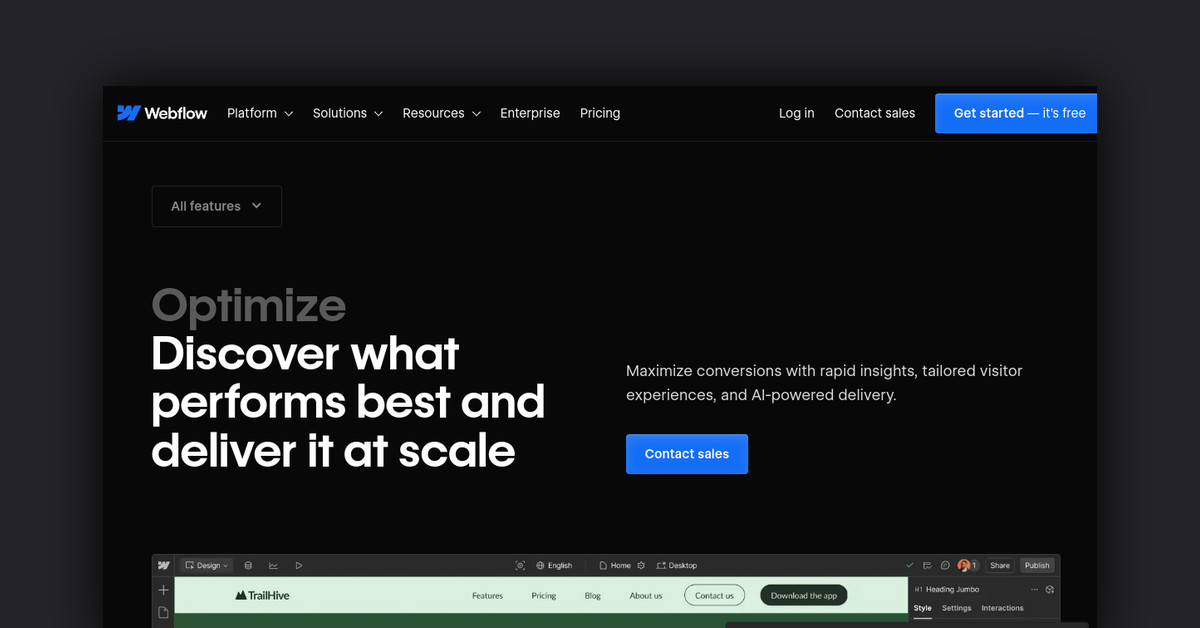Takeaways
- Webflow is a visually-driven web development platform that empowers users to create responsive websites without extensive coding knowledge.
- It features a drag-and-drop interface, generating clean and standards-compliant HTML, CSS, and JavaScript code in the background, providing a robust technical foundation for websites.
- The platform offers a comprehensive suite of tools, including a CMS, e-commerce capabilities, responsive design features, SEO optimization, and hosting services, catering to the needs of both novice and experienced designers.
- Webflow’s versatility makes it suitable for a wide range of applications, from portfolio sites and business websites to e-commerce stores, blogs, and landing pages.
- The platform appeals to designers, developers, entrepreneurs, and marketers, who praise its user-friendly interface, powerful design-development integration, and ability to produce professional-looking websites.
Overview
Webflow is a revolutionary web development platform that bridges the gap between design and code, enabling users to create, build, and launch responsive websites through a visually-driven approach. Designed to empower both designers and non-technical users, Webflow has gained widespread popularity among professionals and entrepreneurs seeking to bring their creative visions to life without extensive programming knowledge.
How Does It Work?
At the heart of Webflow’s functionality is its intuitive, drag-and-drop interface. Users can design websites visually, arranging and manipulating elements on the canvas without the need to write code. Webflow’s advanced technology generates clean, standards-compliant HTML, CSS, and JavaScript code in the background, ensuring that the technical foundation of the websites remains robust and optimized.
What Are All the Features, Functionalities, and Benefits?
Webflow’s comprehensive suite of features caters to the needs of web designers, from novice to expert. These capabilities streamline the web development process while preserving creative freedom.
- Visual Design Interface: Webflow’s intuitive drag-and-drop design tools enable users to create professional-looking websites without writing code.
- Responsive Design: The platform automatically generates responsive websites that adapt seamlessly to different screen sizes, ensuring a consistent user experience across devices.
- CMS (Content Management System): Webflow’s integrated CMS allows users to easily manage and update website content, making it suitable for dynamic, content-driven websites.
- E-commerce Capabilities: Users can build fully functional online stores, manage products, and handle transactions directly within the Webflow platform.
- SEO Optimization: Webflow offers built-in tools to enhance search engine visibility, including clean semantic code, customizable meta tags, and sitemaps.
- Customizable Components: The platform provides a wide range of design components that can be easily tailored to meet the specific needs of each project.
- Hosting Services: Webflow’s reliable hosting solution, with fast loading times and global CDN support, simplifies the website deployment process.
What Are the Use Cases and Potential Applications for It?
Webflow’s versatility enables its application across a diverse range of industries and use cases:
- Portfolio Websites: Artists, photographers, and designers can showcase their work in visually stunning, responsive portfolios.
- Business Websites: Small to medium-sized businesses can establish a professional online presence with Webflow-powered websites.
- E-commerce Sites: Entrepreneurs and online retailers can build fully functional e-commerce stores with integrated payment systems.
- Blogs and Content Sites: Content creators can easily manage and publish their content using Webflow’s CMS capabilities.
- Landing Pages: Marketers can quickly design and launch visually appealing landing pages for their campaigns without requiring extensive developer support.
Who Is It For?
Webflow’s features and capabilities cater to a wide range of users, each benefiting from the platform’s unique strengths:
- Designers: Webflow provides a visual design environment that allows designers to bring their creative ideas to life without the need for extensive coding knowledge.
- Developers: The platform offers a robust foundation for developers to build upon, with the flexibility to customize the code as required.
- Entrepreneurs: Webflow empowers startups and small business owners to create and manage their online presence efficiently.
- Marketers: The platform enables the quick creation and deployment of marketing pages and landing pages for campaigns.
What Are Customers or Users Saying About It?
Webflow has garnered overwhelmingly positive feedback from its users, who praise the platform’s ease of use and powerful features. Customers frequently highlight the seamless integration of design and development tools, allowing them to bring their creative visions to life without sacrificing technical quality. The ability to design responsive websites without coding is a key advantage that has resonated with both novice and experienced users.
List of Useful or Important Links and Resources
For more information and resources about Webflow, the following link is useful:


